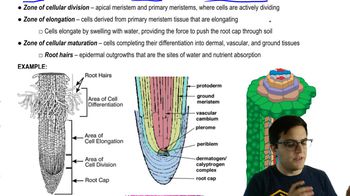Primary and Secondary Growth A tree reaches its imposing size by combining primary and secondary growth. Let's review the two kinds of growth. Here you see the tip of a tree with the taper of the stem exaggerated for clarity. First, let's watch the tree grow, and then analyze the growth regions. Notice that some parts of a tree undergo primary growth at the same time that other parts undergo secondary growth. If the roots were visible, you would see the same thing in the roots. Primary growth occurs in young leaves and elongating parts of the stems and roots. Apical meristems, or regions of rapid cell division, provide cells for primary growth. Secondary growth occurs in regions of stems or roots that have completed their elongation. Leaves rarely have secondary growth. Secondary growth doesn't occur in many short-lived eudicots and most monocots, such as palms and grasses. Secondary growth occurs when a lateral meristem called the vascular cambium adds xylem and phloem to the stem. This picture shows a segment of a tree trunk with the inner tissue zones raised for visibility. The vascular cambium forms secondary phloem toward the stem's surface and secondary xylem that is wood toward the stem's center. That's the main reason why tree trunks thicken with age. Secondary growth also adds cork that protects and waterproofs stems and roots. Cork is made by one or more lateral meristems called cork cambiums, which occur outside the secondary phloem. Cork cambiums work at the same time as the vascular cambium, though we don't show that here. Besides making cork, cork cambiums often make extra storage tissue toward the inside of the stem, though we don't show that here either. The vascular cambium makes xylem and phloem by dividing its cells repeatedly, with outward cells becoming phloem and inward cells becoming xylem. Why doesn't this dual operation consume the cambium? To maintain itself, the vascular cambium alternates between making xylem and phloem. After each cell division, one cell stays meristematic, while the other differentiates, acquiring the features of a xylem or phloem cell. More divisions produce xylem than phloem. That's part of the reason why wood, or the secondary xylem, becomes much thicker than bark, which contains secondary phloem and cork.
Table of contents
- 1. Introduction to Biology2h 40m
- 2. Chemistry3h 40m
- 3. Water1h 26m
- 4. Biomolecules2h 23m
- 5. Cell Components2h 26m
- 6. The Membrane2h 31m
- 7. Energy and Metabolism2h 0m
- 8. Respiration2h 40m
- 9. Photosynthesis2h 49m
- 10. Cell Signaling59m
- 11. Cell Division2h 47m
- 12. Meiosis2h 0m
- 13. Mendelian Genetics4h 41m
- Introduction to Mendel's Experiments7m
- Genotype vs. Phenotype17m
- Punnett Squares13m
- Mendel's Experiments26m
- Mendel's Laws18m
- Monohybrid Crosses16m
- Test Crosses14m
- Dihybrid Crosses20m
- Punnett Square Probability26m
- Incomplete Dominance vs. Codominance20m
- Epistasis7m
- Non-Mendelian Genetics12m
- Pedigrees6m
- Autosomal Inheritance21m
- Sex-Linked Inheritance43m
- X-Inactivation9m
- 14. DNA Synthesis2h 27m
- 15. Gene Expression3h 20m
- 16. Regulation of Expression3h 31m
- Introduction to Regulation of Gene Expression13m
- Prokaryotic Gene Regulation via Operons27m
- The Lac Operon21m
- Glucose's Impact on Lac Operon25m
- The Trp Operon20m
- Review of the Lac Operon & Trp Operon11m
- Introduction to Eukaryotic Gene Regulation9m
- Eukaryotic Chromatin Modifications16m
- Eukaryotic Transcriptional Control22m
- Eukaryotic Post-Transcriptional Regulation28m
- Eukaryotic Post-Translational Regulation13m
- 17. Viruses37m
- 18. Biotechnology2h 58m
- 19. Genomics17m
- 20. Development1h 5m
- 21. Evolution3h 1m
- 22. Evolution of Populations3h 52m
- 23. Speciation1h 37m
- 24. History of Life on Earth2h 6m
- 25. Phylogeny2h 31m
- 26. Prokaryotes4h 59m
- 27. Protists1h 12m
- 28. Plants1h 22m
- 29. Fungi36m
- 30. Overview of Animals34m
- 31. Invertebrates1h 2m
- 32. Vertebrates50m
- 33. Plant Anatomy1h 3m
- 34. Vascular Plant Transport2m
- 35. Soil37m
- 36. Plant Reproduction47m
- 37. Plant Sensation and Response1h 9m
- 38. Animal Form and Function1h 19m
- 39. Digestive System10m
- 40. Circulatory System1h 57m
- 41. Immune System1h 12m
- 42. Osmoregulation and Excretion50m
- 43. Endocrine System4m
- 44. Animal Reproduction2m
- 45. Nervous System55m
- 46. Sensory Systems46m
- 47. Muscle Systems23m
- 48. Ecology3h 11m
- Introduction to Ecology20m
- Biogeography14m
- Earth's Climate Patterns50m
- Introduction to Terrestrial Biomes10m
- Terrestrial Biomes: Near Equator13m
- Terrestrial Biomes: Temperate Regions10m
- Terrestrial Biomes: Northern Regions15m
- Introduction to Aquatic Biomes27m
- Freshwater Aquatic Biomes14m
- Marine Aquatic Biomes13m
- 49. Animal Behavior28m
- 50. Population Ecology3h 41m
- Introduction to Population Ecology28m
- Population Sampling Methods23m
- Life History12m
- Population Demography17m
- Factors Limiting Population Growth14m
- Introduction to Population Growth Models22m
- Linear Population Growth6m
- Exponential Population Growth29m
- Logistic Population Growth32m
- r/K Selection10m
- The Human Population22m
- 51. Community Ecology2h 46m
- Introduction to Community Ecology2m
- Introduction to Community Interactions9m
- Community Interactions: Competition (-/-)38m
- Community Interactions: Exploitation (+/-)23m
- Community Interactions: Mutualism (+/+) & Commensalism (+/0)9m
- Community Structure35m
- Community Dynamics26m
- Geographic Impact on Communities21m
- 52. Ecosystems2h 36m
- 53. Conservation Biology24m
33. Plant Anatomy
Growth
Video duration:
2mPlay a video:
Related Videos
Related Practice



















